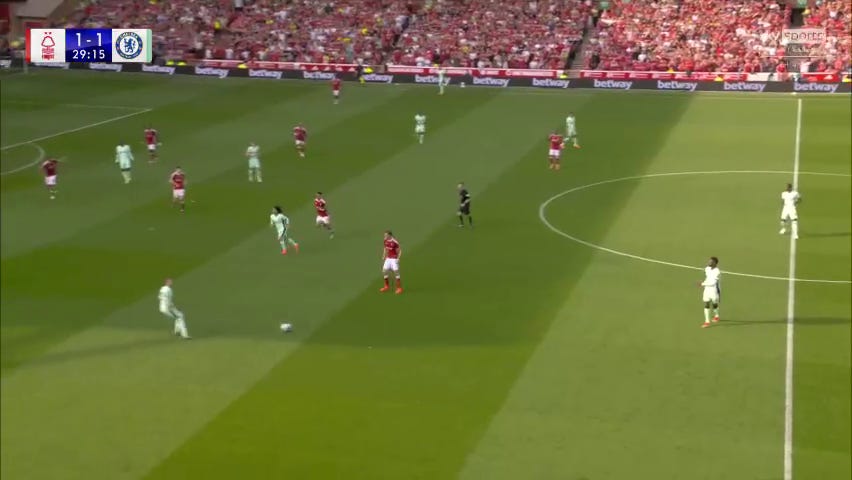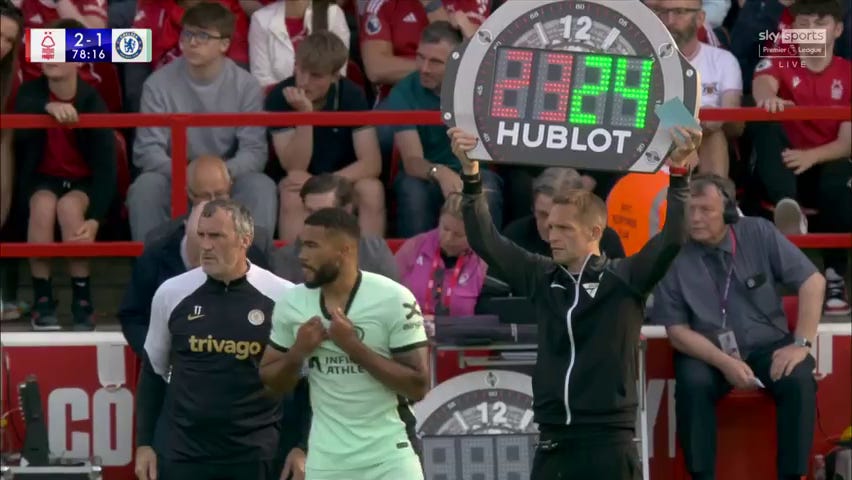Chelsea lined up in their usual 4-2-3-1 with the same lineup that beat West Ham last week. While Forest changed to a back 3 from the back 4 in their previous game against Sheffield and dropped Elanga to the bench, and I will mention why they did that in a minute.
Chelsea in the first half set up to build up in their recently utilised 3-2 shape with Cucurella inverting into midfield, against a much deeper 5-2-3 midblock Forest had set up.
Forest planned for this and therefore prepared to face Chelsea in a 5 at-the-back formation making it harder for Chelsea to break them down. This meant Chelsea had a 5v5 against their defence. So Chelsea had to either win individual battles to naturally kill the block with dribbling, rotate and move men out of position, or overload that block to get numerical advantage.
The challenge in the first half was laid bare to Chelsea to try to penetrate Forest's mid-low block. Chelsea did that very early by rotating and creating a central overload. Chelsea clogged Forest's central areas creating a 3-1-6 shape with Caicedo joining the backline, Chalobah pulling wide.
Cucurella was the single pivot. Noni joined in centrally.
Looking at it, Chelsea outnumbered them about 5 to 3/4 Forest players, so Palmer had time to receive the ball in the LHS. He did this and set Mudryk up perfectly for his goal.
Chelsea seemed to have a plan to break through Forest's midblock. As we saw for the goal. another way they tried was still overloading the centre by putting Caicedo and Cucurella on 2 different horizontal lines as the pivot, that as one is deeper, the other receives in a more forward position. The movements were when Palmer, Conor and Jackson dropped deep to receive the ball and drew Forest players out of position.
The moves needed one or 2 more passes to break through that Forest mid-block after using rotations to get past the block. We could have done with more movements in behind the block as well.
A little more composure from the players especially as our attackers couldn’t get hold of the ball and we would have broken the block a lot more than we did in the first half. The times we did break out of it, we didn’t make the most out of it.
Forest, on the other hand, caused Chelsea lots of problems. Their main threat in attack was their wide players and the overloads of the wingers and wingbacks. Gibbs-White and Hudson-Odoi caused Chelsea problems with their ball-carrying, dribbling and passes into the box. Aina and Montiel (the wingbacks) supported the attacks well and made Chalobah and Cucurella face lots of 2v1's.
Forest were also a real driving force on the counterattack. They possess some of the best ball carriers over distances in the premier league, with the pace and guile of Hudson-Odoi, Gibbs-White, Aina for most of the game, and Elanga (who came in the 2nd half). When Forest won the ball in the midfield, they didn’t hesitate to quickly spring on the counterattack, create multiple chances and eventually get a goal from it.
Forest were also very dangerous on set pieces. And against a team that is fragile on set pieces like Chelsea are, Forest created big chances to threaten Chelsea. Those and counterattacks were a big reason why they had more shots than Chelsea during the game.
Chelsea's biggest chance in the first half came from winning the ball high, a transition-induced moment where Jackson failed to take advantage of the chance. We didn’t seem to try to do that a lot more in the first half. Forest though would rather play it long to the channels and unto Wood so that wasn’t a viable option.
In the 2nd half, Poch first adjusted Cucurella's position from inverting into midfield to staying wider like a regular overlapping full back. The aim was to create more central overloads, leaving Cucurella wide to be an outlet which would still form a 6v5 against Forest's backline, which was a good idea considering Forest still wanted to just frustrate Chelsea in the midblock shape. It is risky as when Forest can win the ball they can have more space to counter, but breaking down low blocks needs the risk of having more bodies overloading to overwhelm blocks. It was similar to what we did in the 2nd half against Crystal Palace.
More players centrally with good movement caused Forest problems. We just needed the final touch.
The first changes of Nkunku and Gusto coming in changed Chelsea's approach to another tried and trusted right side of Gusto and Palmer, and a combination of Palmer and Nkunku we’ve been waiting to see for a long time - they showed some flashes of the link-up. Chelsea were much better and created chances as well.
But Forest's threat on the counter all game paid off. It had been coming and it was CHO who was the main threat. It was terrible how we lost all individual battles on this goal as well and the space between the defence and attack was big enough to attack.
The Sterling and James subs, though at separate times, proved to be the most influential. Sterling replaced Mudryk on the left, while James replaced Gusto and Gusto moved forward as a RM/RW. Palmer and Nkunku played in the half spaces, and Sterling out wide on the left.
The central overload which the shape created with Nkunku, Jackson, Palmer and Gusto when he also came into central areas (since James came on), left space in wider areas for the late runs of James which we took advantage of in 3 minutes approximately since he came on.
James on multiple instances made those late underlapping/overlapping runs off Gusto, which was important for the equaliser as it overloaded the Right flank and CHO and Toffolo (LB) got drawn by the attention of Gusto in midfield.
Poch made the right changes at the right time and with arguably our strongest bench of the season, it showed how much we’ve missed quality players to choose from in this Chelsea team. Big show of character to come back from a 2-1 impending loss to a 3-2 win which shows the team spirit we’ve been building all season. Another win in this winning run continues.
Seun



















Great article of always Seun👍👍👍
Excellent tactical analysis of Nottingham Forest-Chelsea (2-3), Seun.